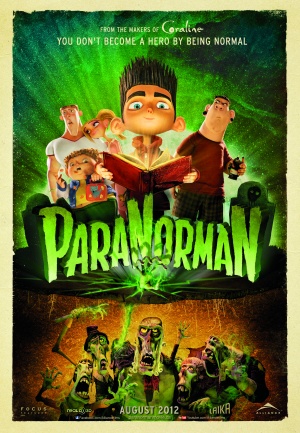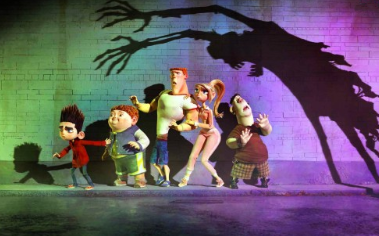
Museum staffers Andi Wang (right) and Anel Muller (left) review movies--past and present--inspired by, related to, or produced by Disney. In honor of The Walt Disney Family Museum's first anniversary YouTube contest they starred in, Wang and Muller will be rating each movie on a scale of facial hair: scruff (worst), mustache, goatee, mutton chops, and full-on beard (best). As we at The Walt Disney Family Museum prepare for the opening of our new exhibition Between Frames: The Magic Behind Stop Motion Animation, "Wang and Muller, Watching Movies" take a look at LAIKA's new film, ParaNorman!
 You don’t become a hero by being normal. You also don’t become an animated classic by following the norm.
You don’t become a hero by being normal. You also don’t become an animated classic by following the norm.
Mainstream animated films are historically made with pen and paper, and are now more commonly created on computers. Stop motion animated films tend to have more of a cult following, rather than becoming blockbuster hits, but LAIKA has created a film that honors its puppet film origins, while also appealing to the masses. Other films in the same genre—such as Nightmare Before Christmas, Coraline, and James and the Giant Peach—are amazing in their own right, but Paranorman elevates the magic of stop motion to a whole new level, placing it on par with the best of other animated Disney and Pixar films.
It seems that the creators of Paranorman dedicated an equal amount of time manipulating the characters frame by frame as they did with fleshing out the storyline. The story unfolds at a good pace, introducing new situations and characters without interrupting the flow of the film. Moreover, unlike other animated films, the audience never forgets they are watching an animated film at any time. But this actually works in the film’s favor, because this enhances the fantasy element within the story.
 With Paranorman, there was no gimmick. The jokes and script itself was witty and sophisticated enough for adults to enjoy, but also simple enough for children, without sacrificing difficult or scary topics. Although there were moments that contained loud and frightening elements that might scare some small children—not the five-year old that accompanied us—there was enough (appropriate) humor scattered throughout that neutralizes this fear, which keeps the film optimistic and grounded. Though a number of the main characters would be considered scary or evil in society, the underlying message of the film works to efficiently transform the audience’s opinion by teaching us that “there’s nothing wrong with being scared, as long as it doesn’t change who you are”.
With Paranorman, there was no gimmick. The jokes and script itself was witty and sophisticated enough for adults to enjoy, but also simple enough for children, without sacrificing difficult or scary topics. Although there were moments that contained loud and frightening elements that might scare some small children—not the five-year old that accompanied us—there was enough (appropriate) humor scattered throughout that neutralizes this fear, which keeps the film optimistic and grounded. Though a number of the main characters would be considered scary or evil in society, the underlying message of the film works to efficiently transform the audience’s opinion by teaching us that “there’s nothing wrong with being scared, as long as it doesn’t change who you are”.
LAIKA is purposeful in every decision they made—not only as we mentioned with the storyline, but also with the physical creation of the film. The puppets, the sets, the lighting—they were all consistently spectacular, beautiful, and overall, just plain COOL. There is one scene in the film that obviously could not have been created without using computer assistance. However, this scene should be used as a lesson to others studios—who use computer graphics for special effects—on how to do it properly and effectively: Use it where it makes sense to enhance the story, not just because you can.
As we rate these films on a scale of facial hair, it seems that a “full-on beard” is just not good enough. Wang and Muller (and Muller JR) feel that this film has left the building and deserves a mountain man—lost in the woods for ten years, with no scissors—full-on beard. What are you doing still reading this review?? Get off your computer and GO SEE IT!!

The views and opinions expressed in the "Wang and Muller, Watching Movies" series are those of the authors, and do not necessarily reflect the official position, thoughts, and opinions of The Walt Disney Family Museum, Walt Disney Family Foundation, or any of its affiliates. [Images and video above ©LAIKA, Inc.]
